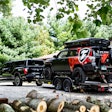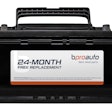 The City of Oakland in California switched from biodiesel to renewable diesel citing more favorable emissions and ease of use.
The City of Oakland in California switched from biodiesel to renewable diesel citing more favorable emissions and ease of use.Hard Working Trucks interviewed vehicle emissions experts at Gladstein, Neandross & Associates to get their feedback on renewable diesel, a synthetic alternative fuel that may be getting more attention in light of more challenging emissions regulations.
Last week, the Obama administration announced new emissions and fuel economy standards for medium- and heavy-duty vehicles which call for a phased-in reduction of up to 25 percent in greenhouse gas (GHG) emissions by model year 2027.
Neste, the largest supplier of renewable diesel in the U.S., reports that its synthetic fuel has been shown to reduce GHG by up to 90 percent when compared to conventional diesel. The fuel’s high cetane value, which ranges between 70 to 90, allows for a cleaner and more efficient burn.
With numbers like these, private and public fleets continue to test and add renewable diesel to their fuel line-up.
New York City announced last month that it would be testing renewable diesel at the Department of Sanitation, which is home to roughly 5,000 Class 8 trucks.
In early May at ACT Expo in California, Carlton Rose, president of global fleet maintenance & engineering at UPS, said that the shipping giant could not get enough renewable diesel and added that the fuel “could be a game changer.”
UPS announced in July of last year that it would be increasing its renewable diesel consumption 15 times over its prior supply rate through new fuel contracts with Neste, Renewable Energy Group and Solazyme. Those purchases amount to 46 million gallons which UPS plans on using over a three-year period.
The State of California and some cities there including San Francisco, Oakland and Carlsbad have switched to Neste’s renewable diesel citing emissions benefits and the ease at which the fuel can be added to existing diesel fuel infrastructure without concerns of phase separation or gelling—challenges which have been associated with biodiesel.
Gladstein, Neandross & Associates (GNA) talked with Hard Working Trucks about renewable diesel. At its website, GNA describes itself as “…the leading North American consulting firm specializing in market development for low emission and alternative fuel vehicle technologies, infrastructure, and fuels for both on- and off-road applications.”
Special thanks to Erik Neandross, CEO of GNA, and Jon Leonard, senior vice-president of GNA’s technical services, for taking the time to answer some questions.
HWT: Given GNA’s experience with alternative fuels, how does renewable diesel (RD) compare to other alt fuels in terms of its emissions?
Leonard: As a “drop-in” fuel for use in existing diesel engines, RD can provide modest reductions in particulate matter (PM), oxides of nitrogen (NOx), carbon monoxide (CO), carbon dioxide (CO2), total hydrocarbons (THC), and most toxic species. However, it remains unclear whether RD provides emissions benefits in modern diesel engines using state-of-the-art emission control systems.
The “bigger picture” about RD-related emissions takes into account the combined system of fuel and advanced diesel engines. To achieve NOx-reduction goals in Southern California and other regions of the U.S.—as needed to attain ozone National Ambient Air Quality Standards—it will be necessary to rapidly phase-in HDVs that emit at (or below) 0.02 g/bhp-hr, which is CARB’s lowest Optional Low- NOx Standard. No heavy-duty diesel engine (using conventional or renewable diesel) has yet been certified at or below the existing NOx standard of 0.2 g/bhp-hr.
This has already been achieved by Cummins Westport’s 8.9-liter ISL G NZ (“near-zero”) natural gas engine, and certification of the 11.9-liter ISX12 G NZ is expected to follow in 2017.
HWT: How does RD compare to other alt fuels in terms of its availability?
Leonard: Availability of RD in the U.S. is certainly still very limited when compared to conventional diesel. However, supplies are available in some niche markets, and supplies are expected to grow. Approximately 325 to 400 million gallons of RD were supplied to U.S. markets in 2014, most of which was imported by one company, Neste. Currently, the greatest U.S. availability and demand for RD is in California, which has received about one third of the U.S. supply (imported and domestic). Currently, most RD sold in California (by any source) is derived from tallow feedstock.
It should be noted that there are concerns about the ability of RD producers to ramp up production to meet additional demand while still relying on tallow and used cooking oil feedstocks. Some other feedstocks, like palm oil, can have significantly poorer GHG benefits and other significant environmental impacts. It’s important for any fleet focused on sustainability to understand where the RD is produced and what feedstocks are used.
HWT: Has GNA ever recommended RD as an alt fuel for any fleet?
Neandross: Yes, GNA has recommended RD as an alt fuel for several of its customers engaged in the commercial transportation sector, including both on-road trucking, transit, and in the off road and marine sectors.
While the focus of this article and publication is predominately on-road, it is also important to note that RD can be used as a petroleum-based diesel fuel substitute in the off-road segment. GNA is working in these areas as well. Unfortunately, we are not at liberty to divulge details on these specific on and off-road projects and client efforts.
HWT: Have fleets been making inquiries at GNA about RD?
Neandross: So far, such inquiries have been limited, although this is starting to change. Last year we had no inquiries. This year, we have been working with a handful of clients to develop and implement RD projects. However, we are still talking about less than 10 in total. We do expect our activity in these areas to increase as awareness of RD grows in the marketplace, in addition to the increased focus and efforts of regulators to develop a 0.02 g/bhp-hr NOx heavy-duty engine standard.
HWT: Given GNA’s ongoing market analysis, what’s the long-term outlook for RD in the U.S.?
Leonard: The long-term outlook for RD in the U.S. appears to be very strong, with California leading the way, and the rest of the nation following. Given the continued increase of carbon-based regulatory activities throughout Canada, we expect that RD will start to be used there as well.
Today, more than 100 million gallons of RD are being used to generate credits in the California LCFS program (roughly 15 percent of all 2014 credits under the LCFS). This is expected to grow in California and other states, as increasing numbers of HDVs are being fueled with RD.
Recent announcements about expanded deployments of HDVs fueled by RD have been made by UPS, the City of San Francisco, Oakland, Walnut Creek, and the California Department of General Services.
HWT: What are some challenges facing RD’s marketability in the U.S. and how might some of those challenges be overcome?
Leonard: Over the longer term, the biggest challenge may be that diesel engines (whether they burn fossil or renewable diesel) must resolve challenging NOx-GHG tradeoffs to survive in the market. Government-industry efforts are underway to develop diesel engines that can meet this challenge.
As with other renewable fuels (including RNG), supply availability is a major potential constraint for expanding RD use into HDV transportation markets. This will be linked to feedstock issues and competition from other markets. Unlike biodiesel, the RD refining process can be controlled to produce different renewable products; these include jet fuel and bio-based chemicals such as naphtha. This makes it more likely that there will be competition from biofuel markets other than on-road HDVs, some of which may be more profitable.
Fuel cost may also be an issue that hinders broad-scale market acceptance. RD costs more to produce than conventional diesel. However, in California, where we have the LCFS (Low Carbon Fuel Standard) program, sellers and/or users of RD can generate revenue through LCFS credits because the carbon intensity rating of RD is much lower than conventional diesel.










